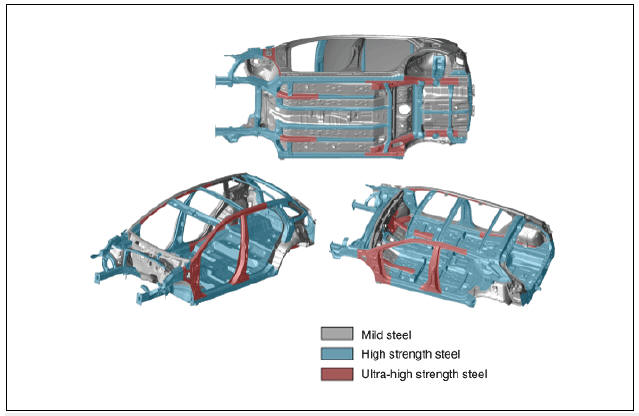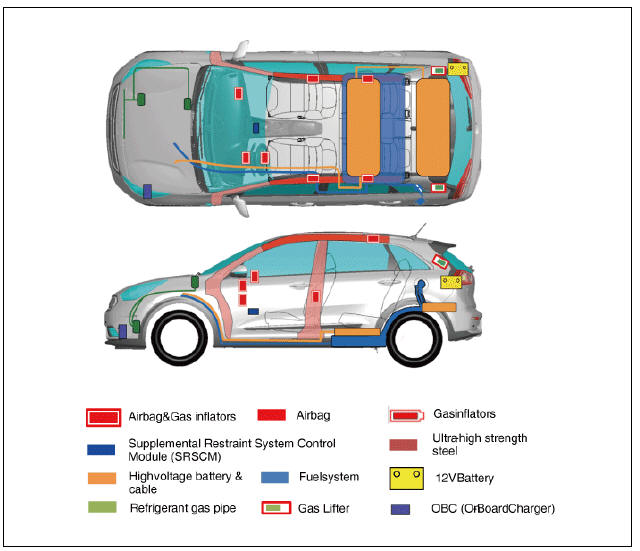KIA Niro: Vehicle Stabilization
Use standard stabilization (cribbing) points, as shown beside. Always be sure to connect to a structural member of the vehicle and avoid placing cribbing under high voltage cables, fuel lines and other areas not normally considered acceptable.

Extraction tools and procedure
When responding to an incident involving a Niro, we recommend that the first responders follow their organization's standard operating procedures for assessing and dealing with vehicle emergencies.
When the first responders cut the vehicle, they should always pay special attention to the airbag system, orange colored high voltage cables and other high voltage components so that the parts are not damaged, causing risks of explosion.
Location of ultra-high strength steel
In the image, high strength steel is used in the areas colored in blue and ultra-high strength steel is used in the red colored areas.
Depending on the tools used, ultra high strength steel can be challenging or impossible to cut. If necessary, use a workaround technique.

NO-CUT ZONES
The areas highlighted in yellow indicate "no-cut zones" that must not be cut during emergency procedures due to high voltage, gas inflators and airbag hazards.
Warning
Do not attempt to enter the vehicle by cutting through the "no-cut zones" identified in the image below. Cutting through these zones can result in death by explosion or electrocution.

Vehicle Fire
After Initial Emergency Response Procedures have been applied, Firefighting Procedures may begin. Kia recommends that each response team follow their own department's standard operating procedures for fighting vehicle fires in combination with the Niro HEV specific details that are covered in this section.
Firefighting Operations
If the high-voltage battery pack is either involved in or at risk of being involved in a fire in a Niro HEV, strict cautions must be taken while conducting firefighting operations due to following reasons:
- Lithium-ion Polymer batteries contain gel electrolyte that can vent, ignite, and produce sparks when subjected to temperatures above 300ºF.
- May burn rapidly with a flare-burning effect.
- Even after the high-voltage battery fire appears to have been extinguished, renewed or delayed fire can occur.
- Use a thermal imaging camera to ensure the high voltage battery is completely cooled before leaving the incident.
- Always advise second responders that there is a risk of the battery re-igniting.
- Fire, submersion or a collision that has compromised the high voltage battery, always store it in an open area with no exposures within 50 feet.
- A burning battery could release hydrogen fluoride, carbon monoxide, and carbon dioxide gasses. Use NIOSH/MSHA approved full-face self-contained breathing apparatus (SCBA) with full protective gear. Even if the high-voltage battery pack is not directly involved in a vehicle fire, approach the vehicle very carefully.
Even if the high-voltage battery pack is not directly involved in a vehicle fire, approach the vehicle very carefully.
Extinguishers
- Small fires that do not involve the high voltage battery should be extinguished using an ABC fire extinguisher for an electrical fire.
- Do not attempt to extinguish fires that involve the high voltage battery with small amounts of water as this can result in electrocution. Fires that involve the high voltage battery should be extinguished using large amounts of water to cool the high voltage battery. Fire fights should not hesitate to pour larger amounts of water on the vehicle in such scenarios.
Submerged or Partially Submerged Vehicles
Some emergency responses can involve a submerged vehicle. Niro HEV that is submerged does not have high-voltage component on the vehicle's body or framework. It is safe to touch the vehicle's body or framework if there is no severe damage to the vehicle, whether it is in water or on land.
In the event of the vehicle is submerged or partially submerged, remove the vehicle from the water before attempting to disable the vehicle. Drain the water from the vehicle. Use one of the methods described to disable the vehicle.
Warning
- If severe damage causes high voltage components to become exposed, responders should take appropriate precautions and wear appropriate insulated personal protective equipment.
- Do not attempt to remove a safety plug while the vehicle is in water.
Failure to follow these instructions can lead to death or serious injury by electrocution.
High Voltage Battery Damage and Fluid Leaks
If electrolyte solution leakage, or damage such as any problem with the Lithium ion battery casing are observed, the first responders should attempt to neutralize the battery by applying a large volume of water to the battery pack while wearing appropriate Personal Protective Equipment (PPE). The neutralization process helps stabilize the thermal condition of the battery pack but does not discharge the battery.
- Cease all smoke, spark, flame around the vehicle.
- Electrolyte solution is a skin irritant.
- Do not touch or step on the spilled electrolyte.
- If electrolyte leak occurs, wear appropriate solvent resistant PPE and use soil, sand, or a dry cloth to clean up the spilled electrolyte. Be sure to adequately ventilate the area.
Warning
Electrolyte Irritation
The high voltage battery contains electrolyte solution. To avoid exposure to electrolyte solution and serious personal injury, always wear appropriate solvent resistant PPE (Personal Protective Equipment) and SCBA (Self-Contained Breathing Apparatus).
- Electrolyte solution is an eye irritant - In the event of contact with eyes, rinse with plenty of water for 15 minutes.
- Electrolyte solution is a skin irritant. Therefore, in the event of contact with skin, wash off with a soap.
- Electrolyte liquid or fumes coming into contact with water will create vapors in the air from oxidization. These vapors may irritate skin and eyes. In the event of contact with vapors, rinse with plenty of water and consult a doctor immediately.
- Electrolyte fumes (when inhaled) can cause respiratory irritation and acute intoxication. Inhale fresh air and wash mouth with water. Consult a doctor immediately.
READ NEXT:
 Roadside Assistance
Roadside Assistance
Towing
In the event of an accident, the high voltage system must be disabled. The
safety plug must be
removed from the high voltage battery according to one of the methods described
in sections of page
17-20 to disable the vehicle.Towing Niro
 Front View Camera Unit
Front View Camera Unit
Front view camera unit
LKA ON/OFF switch
Description
System Function
Lane Keeping Assist (LKA) : The function detects unintentional lane
departure and assists to keep the lane by using alarms
and MDPS steering control.
High Be
SEE MORE:
 Highway Driving Assist settings
Highway Driving Assist settings
Highway Driving Assist is designed to
help detect vehicles and lanes ahead,
and help maintain distance from the
vehicle ahead, maintain the set speed,
help center the vehicle in the lane while
driving on the highway (or motorway).
NOTICE- (
 If an accident
occurs
If an accident
occurs
WARNING
For your safety, do not touch the high
voltage cables, connectors and package
modules. High voltage components
are orange in color.
Exposed cables or wires may be visible
inside or outside of the vehicle.
Never touch the wires
Categories
- Home
- KIA Niro EV, Hybrid - Second generation - (SG2) (2021-2024) - Owner's manual
- Kia Niro - First generation - (DE) (2017-2022) - Service and Repair Manual
- Contact Us
